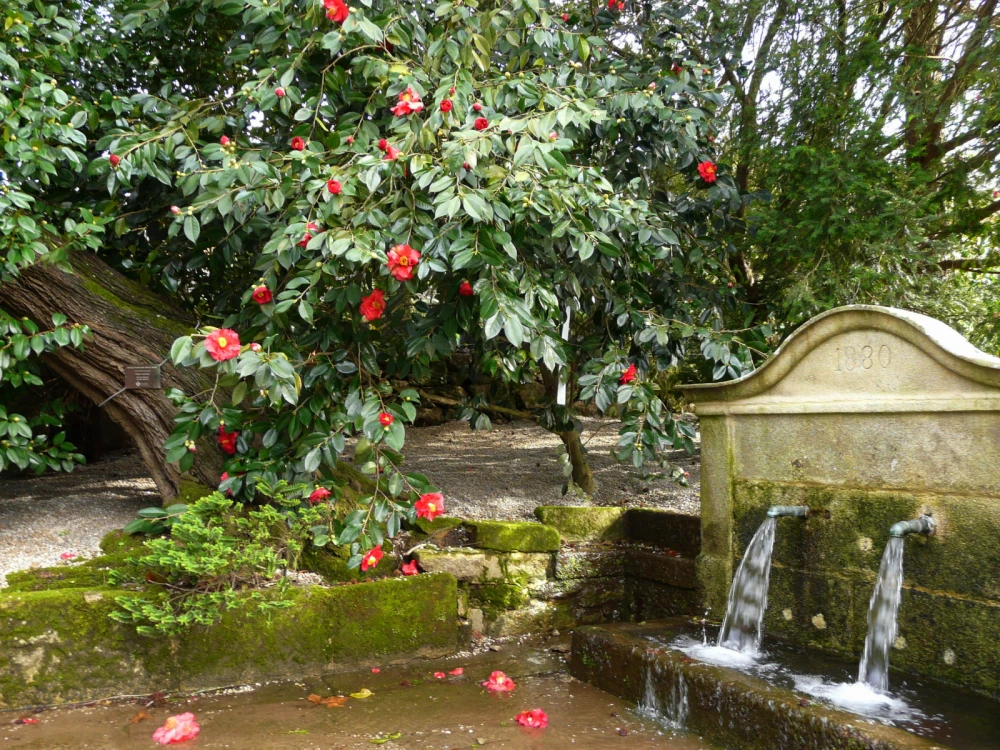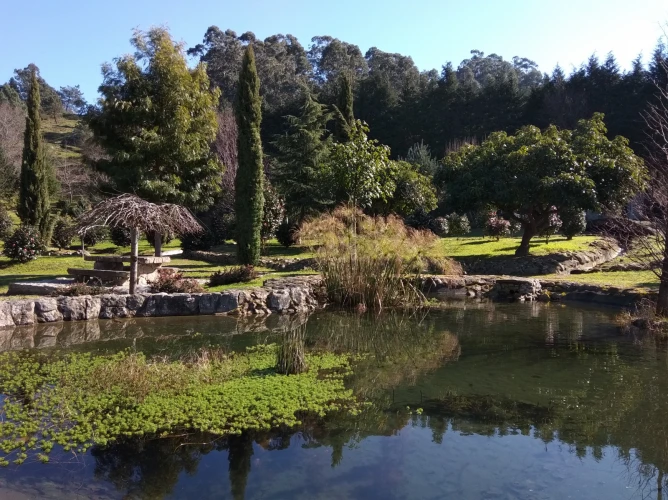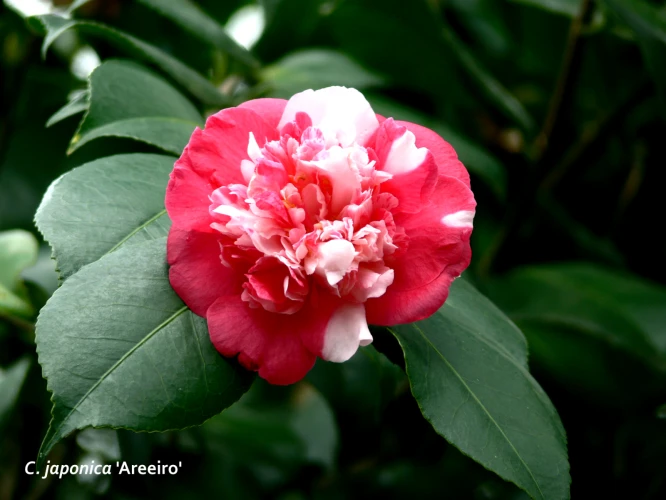Finca Areeiro

Garden Overview
The construction of the original building and the current layout of the property dates back to before the 1880s. The property was then sold and handed over in inheritance on several occasions, until January 1963, when it was purchased by the Deputación de Pontevedra. At that time, there were vineyards, orchards and meadows, as well as some gardens and rest areas. In 1981, the Estación Fitopatolóxica Areeiro (EFA) was created as a response to the will of the provincial organization to fill the existing gap in direct advice to farmers regarding the health of their crops. Today, the EFA is broadly organised into four sections: plant pathology (fungi, bacteria, arthropods, viruses and nematodes), soil science, fruit and ornamentals, and molecular biology. Their units currently carry out diagnostic work, research/experimentation, and dissemination and advice in their respective areas. Their work is not only carried out in the province, but also in other areas of Galicia, Spain and even other European countries, either on their own or through different agreements, conventions or research projects signed with different institutions or organisations.
Since its beginnings, the team have been studying the characteristics of many of the species present in our gardens and their adaptation to our area, thus contributing to the improvement of cultivation methods and controlling their health problems in order to protect the plant heritage of the province.
Areeiro occupies a surface area of six hectares, which includes the buildings, plots with experimental crops and garden areas. There are also greenhouses and shade houses, which are used for propagating and cultivating horticultural, forestry and ornamental species, for developing trials and research projects, for incorporating into the provincial collections, or for donating to municipalities and other public institutions.
Of the original design of the garden, dating from the end of the 19th century, there is still a small area with a pergola and stone table, as well as various stone elements distributed around the estate.
On the left side of the path, there is a fountain dating from 1880, under a majestic specimen of Camellia reticulata 'Royalty'; and on the right, there is a recently restored stone wash house, next to a beautiful large walnut tree and a small glass greenhouse. The road ends at a crossroads: the path on the left leads to the older buildings and garden areas, and the one on the right to newer buildings and agricultural facilities, a vegetable garden, fruit orchards and several areas with camellia trees.
Following the left path is the main building (a former house that has been turned into laboratories and offices), which is entered/accessed by a stone staircase. At the front of the main house, there is a little French garden. At the back of this building is the 19th-century garden. A wrought iron pergola, four magnolia trees (Magnolia grandiflora), a camellia, and two azeroles (Crataegus azarolus), possibly among the oldest in Galicia, have been preserved.
The upper part of the property comprises three terraced areas: the upper one has an experimental 'Albariño' vine plantation; the middle one, walnut trees (Juglans regia) and a forest nursery; and lower part, divided by a wall of Lawson cypresses (Chamaecyparis lawsoniana) and a type of Sawara cypresses (Chamaecyparis pisifera 'Squarrosa'), boasts the Pedro Mansilla Garden, with camellias of different species and origins, specimens that belong to the old avocado plantation and other ornamental plants, such as spider flower trees (Grevillea), ombú, jacarandas, bald cypresses, Jupiter trees and a new collection of citrus trees.
In the same space there is a collection of Higo camellias, of great value because they are known to be associated to Japanese emperors and samurais. Most of them were donated in 2010 by Franco Ghirardi.
In this area, under a small stone bridge, there is a water spring that flows through a channel, until it reaches a pond, where you can see water plants such as papyrus and water lilies. From here, it goes underground until it reaches the old fountain at the entrance.
Our Camellias
The Areeiro camellia collection is made up of 80 species and 1,200 cultivars. The species with most specimens planted in the garden are C. japonica (593), C. sinensis (300), C. Higo (135), C. sasanqua (59), C. reticulata and its hybrids (45) and hybrids (101 including C.x williamsii). The camellias are distributed throughout the garden in 24 areas.
 |
 |
The Deputación de Pontevedra has been involved in the dissemination of the camellia culture for more than 150 years. The oldest specimens planted in the province were originated in the Pontevedra Agricultural School of A Caeira, in the last quarter of the 19th century and also organised the first International Camellia Show, which is still held every year. Thus, due to the importance that this plant has for the province, Areeiro has focused their studies on different aspects as: cultivation, cataloguing and identification of cultivars, propagation, protection, and study of pests and diseases and their yields. This research centre also keeps the living collection of camellias owned by the Deputación de Pontevedra, and carries out research work on study, description and methods to control phytosanitary problems the phenology and adaptability of species and cultivars to our soil and environmental conditions.
The Laboratory of Ornamentals has a public service for characterising and identifying cultivars use of morphobotanical descriptors and molecular markers (SSR) and its technicians are responsible in Spain for including new cultivars in the International Camellia Register. Research is also being done on obtaining secondary metabolites from cell cultures in suspension of Camellia leaves and calluses to be used in the cosmetic and nutraceutical industry.
The composition and properties of camellia oil (obtained by cold pressing the seeds) are analysed at Areeiro, so as to promote the creation of an industrial sector based on camellia products.
After more than 20 years of work, some experimental plantations of C. sinensis clones have been established, and the best adapted and most productive plants have been selected with the aim of obtaining the best tea of the province of Pontevedra.
On 2001, the Spanish Camellia Society was founded in Pontevedra, in 2003, its headquarters moved to Finca Areeiro. Since July 2003, Areeiro has been also the Spanish headquarters of the International Camellia Society (ICS). In 2006, Areeiro, the Spanish Camellia Society and Regional Government of Galicia (Xunta de Galicia) designed a tourism product with the camellia as its central image, and then the Route of the Camellia of Galicia was created which now includes 13 gardens.

Contact Details
FINCA AREEIRO ( Deputación de Pontevedra)
Subida á Carballeira, n. 26
36153 Pontevedra
Spain
Phone: +34 886 201 700; +34 986 4041 00
Email: efa@depo.es
Website: https://areeiro.depo.gal
How to get here: 42º 24´17.19´´N, 8º 40´26´´W (42.406358, -8.673511)
https://areeiro.depo.gal/contacto-onde-estamos
Visitor information
Opening Times
The gardens of Areeiro are open to the public all year .
Guided tours free of charge take place every Tuesday and Thursday (except on public holidays) and two Saturdays a month, from 10 am to 12 noon, each lasting approximately two hours.
Professional and academic groups (universities, agricultural schools, businesses, wineries, etc.) interested in the scientific activities carried out at the Estación Fitopatolóxica Areeiro can request a visit to the laboratories in groups of less than 10 people.
You can make an appointment on the website https://areeiro.depo.gal/visitas-a-finca-areeiro
Entrance fee: Admission is free of charge.
Best Time to Visit
Camellias: Any time, but the best time for camellias is from early autumn (September) to end of spring (April).
Other species: all year round
Gardens of Excellence certification
Instalações
Web design by Tribal Systems
